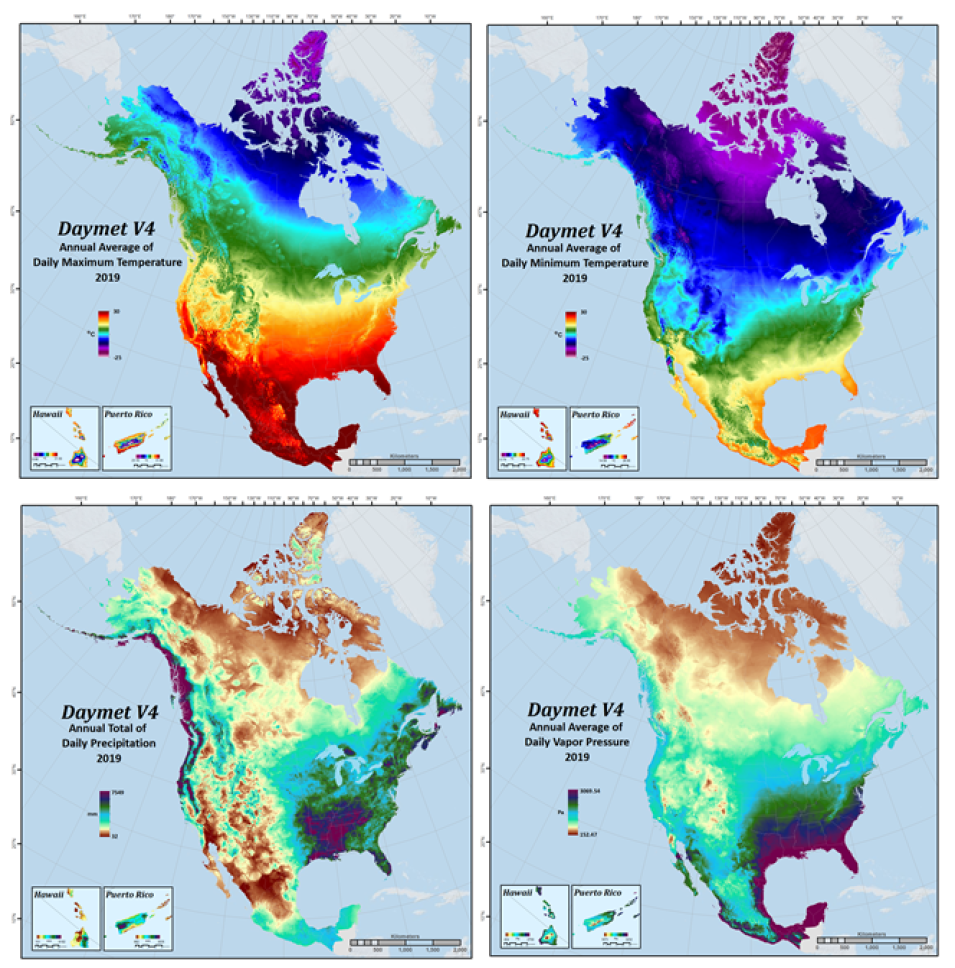“I’m excited to have Daymet Version 4 released,” said Thornton. “With this release we are able to provide the user community a continuation of the data project that they expect while addresses some known legacy issues and station-level input bias adjustments. Continuing to implement improvements and provide updates is important to staying relevant.”
Thornton’s assessment of the dataset’s importance is supported by Daymet’s usage statistics. According to metrics from NASA’s Earth Science Data and Information System (ESDIS) Project, more than 80 terabytes of Daymet data were distributed during the 2020 Fiscal Year (October 1, 2019 through September 30, 2020).
Thornton added that, in early January, there were “hundreds of thousands of downloads” from Daymet’s Single Pixel Extraction Tool, which enables users to acquire daily data from the nearest 1 km x 1 km Daymet grid cell for a single geographic point by latitude and longitude in decimal degrees.
The dataset’s utility is also evident in the nearly 400 peer-reviewed papers that have used some aspect of Daymet data since 2012. Some recent uses of Daymet data include peer-reviewed research into the benefits of artificial drainage on soybean yield in the north central United States, the growth and expansion of birch shrubs in continental Canada, hot weather and risk of drowning in children, Avian responses to extreme weather, and heat wave severity and coverage across the United States. The popularity of Daymet also has led to the creation of community-developed open-source scientific command-line software such as daymetr (an R package) and daymetpy (a Python package), both of which are available through ORNL DAAC's Daymet Resources Learning page.
Yet, Daymet’s impressive use metrics and popularity within the scientific community haven’t stopped Thornton and her ORNL DAAC colleagues from working to make Daymet even better. Among the items on their to-do list are incorporating the meteorological data for 2020, which Thornton said is coming soon, and increasing the frequency of data updates.
“There is a community that wants [the data] to be lower latency,” Thornton said. “We are working toward providing data on a monthly basis this summer.”
Daymet began as a research project created to provide daily weather driver data for terrestrial biogeochemical modelling applications. Improvements to this early model and its algorithm led to the development of Daymet Version 1, a Conterminous US (CONUS) data product, in 1999. Daymet Version 2, which included data from a greater number of weather stations and additional updates, was made available through ORNL DAAC in 2013. At the time, data was only available for CONUS, Hawaii, Puerto Rico, Mexico, and southern Canada up to 52 degrees North. The inclusion of data from additional weather stations and further algorithm enhancement led to the development of Daymet Version 3, which was released in 2016, offered spatial coverage of all of North America.
Improvements to Daymet’s core algorithm and bias assessments were supported by the Office of Biological and Environmental Research within the DOE's Office of Science. The standardization, curation and distribution following FAIR data standards of Daymet V4 are supported by funding from NASA through ESDIS and the Terrestrial Ecology Program. ORNL DAAC is responsible for managing, archiving, and distributing data in NASA’s Earth Observing System Data and Information System (EOSDIS) collection pertaining to biogeochemical dynamics, ecology, and environmental processes.
To learn more about the ORNL DAAC data, services, and tools, visit the ORNL DAAC website.
To learn how to use Daymet and its data analysis tools, visit the Learning page on the Daymet website.
To discover and access ORNL data by scientific theme or NASA project, or to see a complete list of available datasets, visit the website’s Get Data page.

